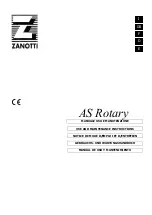
English
Voltage Limitations:
According to CEI EN 60204-1, Pfannenberg standard Chiller operation is guaranteed within these ranges:
•
Nominal voltage ±10 % [V]
•
Nominal frequency ±1 % [Hz]
Please refer to the type label to see which are the operating nominal conditions of the unit.
Nominal conditions
V min
[V]
V max
[V]
f min
[Hz]
f max
[Hz]
230 V / 1 ~ / 50 Hz
207
253
49.5
50.5
230 V / 1 ~ / 60 Hz
207
253
59.4
60.6
400 V / 3 ~ / 50 Hz
360
440
49.5
50.5
460 V / 3 ~ / 60 Hz
414
506
59.4
60.6
For units with special voltages please refer to the type label.
7 Process Water / Fluids
PFANNENBERG chillers should be filled to the proper level with an
inhibited glycol
designed for Industrial chillers systems.
Do
not use automotive antifreeze!
The inhibitors used in automotive antifreeze can break down quickly and accelerate the
degradation of the coolant base (glycol); as well as promote corrosion in a system. Silicates used in automotive antifreeze coat
heat exchangers, resulting in reduced heat transfer. Also, silicates can gel causing fouling and plugging of a system.
The ratio of inhibited glycol to water should be adequate to prevent freezing at the lowest ambient temperature. Check the level
with all lines filled.
The glycol mixture should be checked periodically (3 to 6 months) for proper concentrations
. When
filling the system, always use a pre-mixed solution in the proper ratio to maintain freeze and corrosion protection.
Demineralized/deionized water is
recommended
because many municipal water supplies contain large amounts of chlorine,
which can react unfavorably with glycol.
NOTE: If user’s circuit is at least 500mm over the hydraulic connection of the chiller, the fluid in the piping may drain
back and overflow the chiller reservoir if the chiller is shut down. This can be prevented by using a check valve in the
supply line, and either a solenoid valve on the return line.
Corrosion protection:
PFANNENBERG recommends that Pfannenberg Protect Glycol is also used as a rust inhibitor.
The percentages of glycol into the mixture is related to the minimum working temperature of the mixture (that must be in line
with the minimum working set point of the unit, please see the technical data of the unit):
Propylene glycol
dilution
Working range temperature
Freezing point
%
Min [°C]
Max [°C]
PP20P
20
+10
+101
-8
PP30P
30
0
+103
-14
PP50P
54
-25
+104
-38
Ethylene glycol
dilution
Working range temperature
Freezing point
%
Min [°C]
Max [°C]
PP20E
20
+10
+102
-8
PP30E
30
0
+103
-15
PP50E
50
-25
+108
-38
70040-106_01-C_EN-DE-IT_comp.doc
10











































